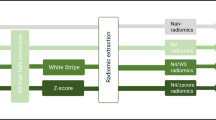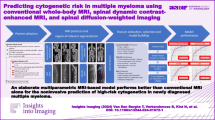Abstract
Objectives
The purposes of this MR-based study were to calculate q-space imaging (QSI)–derived mean displacement (MDP) in meningiomas, to evaluate the correlation of MDP values with apparent diffusion coefficient (ADC) and to investigate the relationships among these diffusion parameters, tumour cell count (TCC) and MIB-1 labelling index (LI).
Methods
MRI, including QSI and conventional diffusion-weighted imaging (DWI), was performed in 44 meningioma patients (52 lesions). ADC and MDP maps were acquired from post-processing of the data. Quantitative analyses of these maps were performed by applying regions of interest. Pearson correlation coefficients were calculated for ADC and MDP in all lesions and for ADC and TCC, MDP and TCC, ADC and MIB-1 LI, and MDP and MIB-1 LI in 17 patients who underwent subsequent surgery.
Results
ADC and MDP values were found to have a strong correlation: r = 0.78 (P = <0.0001). Both ADC and MDP values had a significant negative association with TCC: r = –0.53 (p = 0.02) and –0.48 (P = 0.04), respectively. MIB-1 LI was not, however, found to have a significant association with these diffusion parameters.
Conclusion
In meningiomas, both ADC and MDP may be representative of cell density.
Key Points
• Diffusion-weighted MRI offers possibilities to assess the aggressiveness of meningiomas.
• The q-space imaging-derived mean displacement correlates strongly with apparent diffusion coefficients.
• Both diffusion parameters showed a strong negative association with tumour cell counts.
• Derived mean displacement may help assess the aggressiveness of meningiomas preoperatively.




Similar content being viewed by others
Abbreviations
- QSI:
-
q-Space imaging
- MDP:
-
Mean displacement
- DWI:
-
Diffusion-weighted imaging
- ADC:
-
Apparent diffusion coefficient
- MIB-1 LI:
-
MIB-1 labelling index
References
Nagar VA, Ye JR, Ng WH et al (2008) Diffusion-weighted MR imaging: diagnosing atypical or malignant meningiomas and detecting tumor dedifferentiation. AJNR Am J Neuroradiol 29:1147–1152
Filippi CG, Edgar MA, Uluğ AM, Prowda JC, Heier LA, Zimmerman RD (2001) Appearance of meningiomas on diffusion-weighted images: correlating diffusion constants with histopathologic findings. AJNR Am J Neuroradiol 22:65–72
Pavlisa G, Rados M, Pazanin L, Padovan RS, Ozretic D (2008) Characteristics of typical and atypical meningiomas on ADC maps with respect to schwannomas. Clin Imaging 32:22–27
Santelli L, Ramondo G, DellaPuppa A et al (2010) Diffusion-weighted imaging does not predict histological grading in meningiomas. Acta Neurochir 152:1315–1319
Chen TY, Lai PH, Ho JT et al (2004) Magnetic resonance imaging and diffusion weighted images of cystic meningiomas: correlating with histopathology. Clin Imaging 28:10–19
Hakyemez B, Yildirim N, Gokalp G, Erdogan C, Parlak M (2006) The contribution of diffusion-weighted MR imaging to distinguishing typical from atypical meningiomas. Neuroradiology 48:513–520
Sanverdi SE, Ozgen B, Oguz KK et al (2011) Is diffusion-weighted imaging useful in grading and differentiating histopathological subtypes of meningiomas? Eur J Radiol 81:2389–2395
Kono K, Inoue Y, Nakayama K et al (2001) The role of diffusion-weighted imaging in patients with brain tumors. AJNR Am J Neuroradiol 22:1081–1088
Hayashida Y, Hirai T, Morishita S et al (2006) Diffusion-weighted imaging of metastatic brain tumors: comparison with histologic type and tumor cellularity. AJNR Am J Neuroradiol 27:1419–1425
Sugahara T, Korogi Y, Kochi M et al (1999) Usefulness of diffusion-weighted MRI with echo-planar technique in the evaluation of cellularity in gliomas. J Magn Reson Imag 9:53–60
Gauvain KM, McKinstry RC, Mukherjee P et al (2001) Evaluating pediatric brain tumor cellularity with diffusion-tensor imaging. AJR Am J Roentgenol 177:449–454
Hatakenaka M, Soeda H, Yabuuchi H et al (2008) Apparent diffusion coefficients of breast tumors: clinical application. Magn Reson Med Sci 7:23–29
Fatima Z, Motosugi U, Hori M et al (2012) Age-related white matter changes in high b-value q-space diffusion-weighted imaging. Neuroradiology. doi:10.1007/s00234-012-1099-4
Assaf Y, Ben-Bashat D, Chapman J et al (2002) High b-value q-space analyzed diffusion-weighted MRI: application to multiple sclerosis. Magn Reson Med 47:115–126
Fatima Z, Motosugi U, Hori M et al (2012) High b-value q-space analyzed diffusion-weighted MRI using 1.5 Tesla clinical scanner; determination of displacement parameters in the brains of normal vs. multiple sclerosis and low-grade glioma subjects. J Neuroimaging 22:279–284
Fatima Z, Motosugi U, Hori M et al (2010) q-space imaging (QSI) of the brain: comparison of displacement parameters by QSI and DWI. Magn Reson Med Sci 9:109–110
Niendorf T, Dijkhuizen RM, Norris DG, van Lookeren Campagne M, Nicolay K (1996) Biexponential diffusion attenuation in various states of brain tissue: implications for diffusion-weighted imaging. Magn Reson Med 36:847–857
Santos JMG, Ordonez C, del Rio ST (2008) ADC measurements at low and high b values: insight into normal brain structure with clinical DWI. Magn Reson Imaging 26:35–44
Schwarcz A, Bogner P, Meric P et al (2004) The existence of biexponential signal decay in magnetic resonance diffusion-weighted imaging appears to be independent of compartmentalization. Magn Reson Med 51:278–285
Hori M, Fatima Z, Motosugi U et al (2011) A comparison of mean displacement values using high b-value q-space diffusion-weighted MRI with conventional apparent diffusion coefficients in patients with stroke. Acad Radiol 18:837–841
Tanaka G, Nakazato Y (2004) Automatic quantification of the MIB-1 immunoreactivity in brain tumors. Int Congr Ser 1259:15–19
Dorenbeck U, Grunwald IQ, Schlaier J, Feuerbach S (2005) Diffusion-weighted imaging with calculated diffusion coefficient of enhancing extra-axial masses. J Neuroimaging 15:341–347
Ginat DT, Mangla R, Yeaney G, Wang HZ (2010) Correlation of diffusion and perfusion MRI with Ki-67 in high grade meningiomas. AJR Am J Roentgenol 195:1391–1395
Higano S, Yun X, Kumabe T et al (2006) Malignant astrocytic tumors: clinical importance of apparent diffusion coefficient in prediction of grade and prognosis. Radiology 241:839–846
Calvar JA, Meli FJ, Romero C et al (2005) Characterization of brain tumors by MRS, DWI and Ki-67 labeling index. J Neurooncol 72:273–280
Abramovich CM, Prayson RA (1998) MIB-1 labeling indices in benign, aggressive, and malignant meningiomas: a study of 90 tumors. Hum Pathol 29:1420–1427
Yue Q, Shibata Y, Isobe T et al (2009) Absolute choline concentration measured by quantitative proton MR spectroscopy correlates with cell density in meningioma. Neuroradiology 51:61–67
Acknowledgments
We acknowledge the invaluable contributions of Mr. Hiroshi Kumagai and Mr. Satoshi Ikenaga, Department of Radiology, University of Yamanashi, in carrying out all the imaging for this study.
Author information
Authors and Affiliations
Corresponding author
Rights and permissions
About this article
Cite this article
Fatima, Z., Motosugi, U., Waqar, A.B. et al. Associations among q-space MRI, diffusion-weighted MRI and histopathological parameters in meningiomas. Eur Radiol 23, 2258–2263 (2013). https://doi.org/10.1007/s00330-013-2823-0
Received:
Revised:
Accepted:
Published:
Issue Date:
DOI: https://doi.org/10.1007/s00330-013-2823-0




